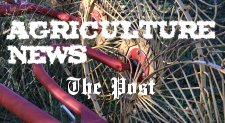To enhance forage quality, cut your pasture down to size
 Springtime heralds the arrival of good growing conditions, and many pastures are growing faster than the cattle can graze them. To have an efficient forage and cattle production program, Dr. Gary Bates, director of the University of Tennessee Beef and Forage Center, says producers need to understand forage growth and its impact on quality.
Springtime heralds the arrival of good growing conditions, and many pastures are growing faster than the cattle can graze them. To have an efficient forage and cattle production program, Dr. Gary Bates, director of the University of Tennessee Beef and Forage Center, says producers need to understand forage growth and its impact on quality.
“If you were to break down the goal of your forage production program to its simplest terms, it would be to grow as many leaves as possible,” Bates explains. “This is because leaves are the highest quality portion of the plant, containing more protein and energy and less fiber than the other portions of the plant. The more leaves, the higher the quality forage,” he said.
However, Bates cautions that as the leaves get older, their quality drops because fiber is being produced at a much faster rate than protein, and a higher protein content is more desirable for livestock nutrition. “It would be nice if the leafy, high quality pastures we have in the spring would stay just as they are, but this is never the case. The pastures will drop in quality if they are not utilized.”
A second reason pastures drop in quality is because of seedheads. As the plants change from vegetative growth, that is producing leaves, to reproductive growth (producing blooms and seeds), the quality of the forage for livestock nutrition drops. “A seedhead has to stay up in the air in order to be pollinated and produce seed. To stay high and not fall over, there has to be a lot of fiber in the stalk,” said Bates. “This fiber is good for the seedhead, but bad for the forage quality. There is very little protein in a seedhead.”
“If you want to maintain a high quality pasture, then you need to minimize the amount of seedheads and old leaves that are present in the pasture,” the expert recommends. “The only way to do this is to remove the older forage and seedheads. “If you are getting excess forage from a pasture, don’t hesitate to cut one or two of your fields for hay,” he advises. “This will remove the old forage and force the plants to regrow leaves, which will be high quality.”
Bates also reminds producers that it is helpful to put limits on the area that livestock can graze. “If you let your cows have access to too much pasture, they will waste a lot because they have too much forage to choose from. The overall quality of the forage will drop,” he said. Bates recommended erecting a temporary electric fence to reduce the available pasture and force the cows to eat a higher percentage of the forage in the available field.
“Cut hay from the field that the cattle haven’t grazed,” he said. “Then as we move into the summer and pastures aren’t growing as fast, the land used early for hay can be transferred into the grazing program.”
Bates explains that one of the key points for successful forage production is for producers to use everything they grow. “Don’t be guilty of using good production practices and then using poor harvest practices. All of the forage you grow should be used as grazing or hay. If you don’t use the high quality, then you will lose it,” the expert said.
For more information about forages and pasture management, contact The UT Jefferson County Extension office or visit the UT Forage website: http://forages.tennessee.edu/











